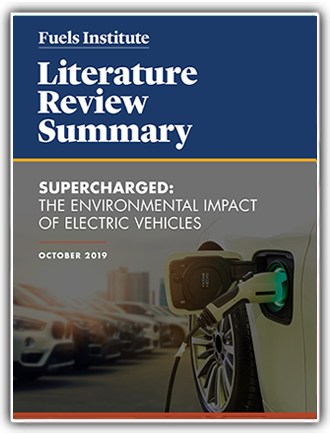The NACS Fuels Institute Study: Environmental And Economic Impact of Electric Vehicles Vs. Internal Combustion Powered Vehicles”
 |
MORE ON THE AUTO CHANNEL:
- To Reduce Harmful Emissions From Internal Combustion Engines - Just Replace Gasoline With Clean Burning Ethanol Blends
- Electric Vehicles, Solution, Diversion or China Economic Warfare?
ALEXANDRIA, Va. October 31, 2019; Electric vehicles (EVs) have the potential to reduce harmful emissions, including greenhouse gases (GHG), but they may not be the best option for emissions reduction in all markets, according to a new literature review released this week by the Fuels Institute.
“Supercharged: The Environmental Impact of Electric Vehicles” uncovered a number of factors that ultimately influence the environmental performance of EVs, including where the vehicles are driven and charged, and these variables are important to consider when deciding where deployment makes the most environmental sense.
“A lot has been written about the impact of electric vehicles. Some reports suggest electric vehicles are the definitive clean transportation option; yet other reports indicate technical advances in internal combustion engines and increased fuel economy could contribute to a cleaner environment than EVs,” said John Eichberger, executive director of the Fuels Institute.
As EVs continue to gain market share, debate continues about their overall environmental impact. While EVs are often touted as the environmentally friendly option relative to the internal combustion engine (ICE), assessing and comparing the entire lifecycle of EVs and ICEs is necessary to determine their environmental impact. To provide an objective, high-level overview of the environmental performance of EVs, the Fuels Institute reviewed more than 30 reports recommended by key stakeholders to learn how each vehicle’s manufacture, distribution and use affects the environment.
Overall, the consensus from the literature is that while EVs produce zero tailpipe emissions, they are still a source of emissions due to the generation of electricity they consume and their production, disposal and recycling, etc. The power generation characteristics of a market influence the environmental performance of EVs as well. One of the key takeaways is that at present, depending upon the electricity generation mix and location of the power plant and vehicle, EVs can end up shifting pollutants away from the road to electricity generation stations. However, some reports point out that the impact of this trend will only decline as powerplants switch to renewable sources of energy.
At the same time, ICE vehicles are becoming cleaner and more efficient due to stringent emissions standards, low-sulfur fuels and advanced powertrains, and they can present a credible and sometimes preferential environmental option in certain markets. As the report found, “the use of EVs in regions where electricity is generated by coal, lignite or heavy oil combustion is counterproductive…In these cases, increasing the fuel efficiency of ICEs could produce a more significant reduction in greenhouse gas emissions.”
Commenting on the two kinds of vehicles, Eichberger said, “Headlines do not always tell the whole story, and with regard to EVs, you have to look deeper than the lack of tailpipe emissions to properly evaluate when and where deployment makes the most environmental sense.”
Download the Fuels Institute’s full report here.


